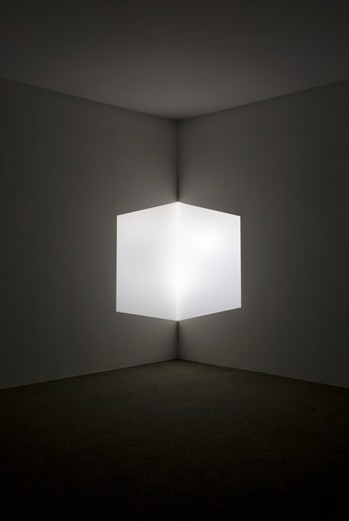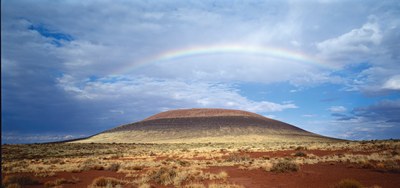The Radical Reality of James Turrell:
“Opening this Sunday is James Turrell: A Retrospective—a large-scale survey of Turrell’s career filling galleries in both BCAM and the Resnick Pavilion. Michael Govan, LACMA’s Wallis Annenberg Director, serves as co-curator of the exhibition along with contemporary art curator Christine Y. Kim. Below is an excerpt from Govan’s essay ‘Inner Light,’ found in full in the accompanying exhibition catalogue co-published by LACMA and DelMonico Books/Prestel.

James Turrell, Afrum (White), 1966, Cross Corner Projection, LACMA, partial gift of Marc and Andrea Glimcher in honor of the appointment of Michael Govan as CEO and Wallis Annenberg Director and purchased with funds provided by David Bohnett and Tom Gregory through the 2008 Collectors Committee, © James Turrell, photo © 2013 Museum Associates LACMA
The theme of light has preoccupied artists for centuries. Leonardo da Vinci wrote volumes about the importance of light in rendering nature; Romantic artists described the sublime through light; and others, from Russian icon painters to modern artists, used abstract forms to account for a divine or inner light. No one, however, has so fully considered the ‘thingness’ of light itself—as well as how the experience of light reflects the wondrous and complex nature of human perception—as James Turrell has more than four decades. As the artist himself explains of his work, ‘Light is not so much something that reveals as it is itself the revelation.’
During the 1960s, Turrell emerged as one of the most radical of a new generation of artists. At a moment when American art in particular was dealing with extremely simplified forms (which were the beginnings of Minimalism), Turrell applied this approach to nothing—no object, only light and perception. His earliest light projections and constructions conjure a material perception of the immaterial, and in his (still unfinished) magnum opus, Roden Crater, Turrell goes beyond even that. One of the most ambitious artworks ever conceived, representing forty years of ongoing work to convert an extinct volcanic crater in northern Arizona, Roden Crater—through light—conveys the vastness of the cosmos within the tangible space of human experience.

James Turrell, Roden Crater Project, view toward northeast, photo © Florian Holzherr
By devising means to hold light as an isolated and almost tactile substance, Turrell has created opportunities for us to experience it as a primary physical presence rather than as a tool through which to see or render other phenomena. Viewing his work, we are called upon not to consider what is being lit but instead to contemplate the nature of the light itself—its transparency or opacity, its volume, and its color, which is often perceived as changing, thus adding a temporal aspect to the experience. Turrell’s work is especially ‘modern’ in this sense. So often it is presumed that the most revolutionary aspect of (Western) modern art is a tendency toward abstraction or intellectualization, accompanied by a distancing of emotion. But quite the opposite is true: as Cubism offers multiple points of view at once; as Color Field Painting and Hard Edge Abstraction isolate visual phenomena through distinct color and form; as Abstract Expressionism allows the materiality of paint or canvas to dominate composition or subject; as Surrealism excavates the unconscious and brings it to the surface; as Conceptualism can provide more direct access to the artist’s intentions; and as photography has often concerned itself with verisimilitude, much modern and contemporary art strives to heighten awareness of our own perception and understanding more than artworks based on conventional narrative, symbolic, or illustrative structures. Turrell’s Skyspaces—essentially rooms with apertures that open to the sky—afford the immediacy of pure color and light without the distractions of image or even paint, dramatizing the materialization of our own perception characteristic of modern art as they magically bring the sky we take for granted as being far away into our intimate physical space. There could be no better illustration of art’s capacity to put an otherwise distant truth directly in front of us than the heroic gesture of bringing the sky down to earth for our immediate consideration. Turrell closes the gap between the thing perceived and the perceiving being as he plays with the very act of seeing itself.”
Read more here: The Radical Reality of James Turrell
Michael Govan, LACMA CEO and Wallis Annenberg Director
(Via Unframed The LACMA Blog.)
